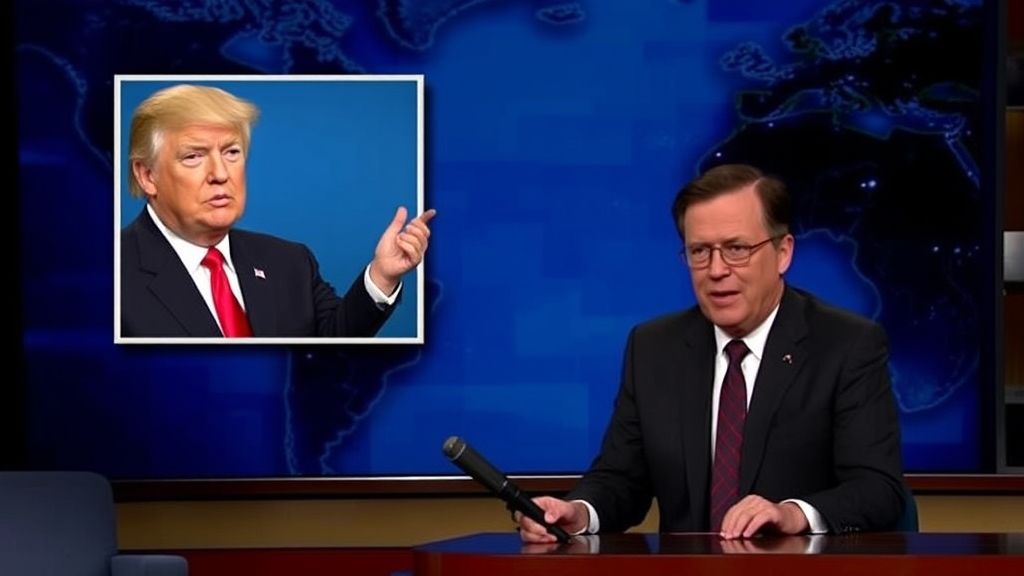In the ever-evolving landscape of political commentary, few figures possess the enduring wit and incisive humor of David Letterman. Recently, the legendary talk show host resurfaced a classic clip that not only eviscerated a past attack by Donald Trump but also served as a potent reminder of Letterman’s unparalleled ability to dissect and ridicule absurdity. This throwback moment, a masterclass in comedic precision, offers invaluable lessons for anyone seeking to effectively counter flawed arguments and expose hypocrisy.
The Genius of the Throwback: Context is King
The clip in question dates back to a period when Donald Trump, much like his current rhetorical style, was prone to making sweeping, unsubstantiated claims. Letterman, with his signature deadpan delivery and meticulous attention to detail, didn’t just dismiss Trump’s statements; he surgically deconstructed them. The brilliance lay in the throwback aspect. By re-contextualizing Trump’s past pronouncements against the backdrop of his present actions and words, Letterman highlighted a consistent pattern of bluster and self-serving narrative.
This strategy is a powerful tool for several reasons:
Undermines Credibility: Re-showing past contradictory statements directly challenges an individual’s present claims. It demonstrates a history of unreliability, making it harder for them to be taken seriously.
Reveals Patterns: A single instance of an attack might be an anomaly. However, when a pattern of similar behavior or rhetoric is exposed, it becomes a character trait rather than an isolated incident.
Leverages Nostalgia (and Irony): For long-time viewers, a throwback clip can evoke a sense of shared experience and underscore how little some things have changed, amplifying the comedic effect through irony.
Empowers the Audience: By presenting evidence in a clear, often humorous, ma
er, Letterman empowers his audience to draw their own conclusions, making the critique more impactful than a simple assertion.
Consider the real-world application of this. In a business negotiation, a seasoned negotiator might recall a previous instance where a potential partner misrepresented facts, using that past behavior to question their current proposal. In public discourse, activists often employ archival footage to highlight a politician’s broken promises or evolving stances on critical issues. Letterman’s approach operationalizes this principle with unparalleled comedic flair.
Deconstructing Trump’s Attack: The Letterman Method
Letterman’s method wasn’t about shouting over Trump or resorting to ad hominem attacks. Instead, he employed a multi-pronged approach that can be broken down into key components:
1. The Setup: Precisely Chosen Evidence
Letterman didn’t pick just any clip. He selected moments where Trump’s claims were particularly audacious, easily verifiable as false, or demonstrably hypocritical. This precision in choosing the “evidence” is crucial. A weak or irrelevant example dilutes the impact of the entire critique. Imagine a lawyer presenting their case; they wouldn’t introduce a tangential piece of evidence that doesn’t directly support their argument. Similarly, Letterman presented clips that were directly relevant to the specific attack he was dissecting.
2. The Contrast: Juxtaposition for Maximum Impact
The true power of the throwback clip lay in the juxtaposition. Letterman would often place Trump’s earlier statements side-by-side with current realities, or even with Trump’s own later statements, exposing the blatant contradictions. This visual and auditory contrast creates an immediate and undeniable sense of absurdity.
Example: If Trump claimed to be a brilliant negotiator in the past, Letterman might then cut to a news report detailing a failed business venture under Trump’s leadership. The viewer is left to ponder the disco
ect.
This technique is not dissimilar to how advertisers use “before and after” scenarios to showcase the effectiveness of their products. In Letterman’s case, the “before” was Trump’s claim, and the “after” was the often-contrary reality.
3. The Punchline: The Inevitable Comic Revelation
Letterman’s genius was in how he framed the punchline. It wasn’t just about pointing out the falsehood; it was about the delivery that made the audience feel the ridiculousness. His sardonic tone, subtle facial expressions, and well-timed pauses all contributed to the comedic devastation. He allowed the absurdity of the situation to speak for itself, often with minimal commentary. This is a key takeaway for anyone aiming to critique: let the facts, presented effectively, do the heavy lifting.
Actionable Insights for Effective Counter-Arguments
David Letterman’s masterful dismantling of Donald Trump’s attack offers several actionable insights applicable to various communication scenarios:
Master Your Facts: Before engaging in any critique, ensure you have a solid foundation of factual information. Misinformation, even when used to expose another’s falsehood, is counterproductive.
Identify the Core of the Argument: What is the central claim being made? Your counter-argument should directly address this core.
Seek Out Past Inconsistencies: If a person or entity has a history of contradictory statements or actions, these are potent ammunition. Dig for those instances.
Utilize Visual and Auditory Aids: If possible, use clips, images, or documented evidence to support your points. This makes your argument more engaging and memorable.
Embrace Nuance and Restraint: While humor can be powerful, avoid gratuitous insults. Let the evidence speak for itself, and use a measured tone to enhance your credibility.
Understand Your Audience: Tailor your approach to resonate with the people you are trying to reach. Letterman understood his audience and their capacity for recognizing irony and hypocrisy.
Practical Applications:
Journalism: Investigating and presenting past statements that contradict current narratives.
Debate: Using historical records and prior statements to challenge an opponent’s position.
Public Relations: Proactively addressing past criticisms or missteps with clear, evidence-based explanations.
- Personal Communication: When discussing disputed issues, calmly referencing past agreed-upon facts or demonstrated behaviors.
Conclusion: The Enduring Power of Wit and Truth
David Letterman’s recent resurfacing of a classic clip serves as a powerful testament to the enduring impact of intelligent satire. By expertly leveraging past statements to expose the hollowness of present claims, he not only delivered a stinging critique but also provided a valuable blueprint for effective communication. In an era saturated with information and often-polarized discourse, the ability to cut through the noise with wit, backed by irrefutable evidence, remains one of the most potent tools at our disposal. Letterman’s throwback moment is a reminder that sometimes, the most effective way to shut down a flawed argument is not with more noise, but with the sharp, clear echo of truth, delivered with a touch of comedic brilliance.



